This post contains affiliate links (I get a commission at no extra cost to you for purchases made through links in this post).
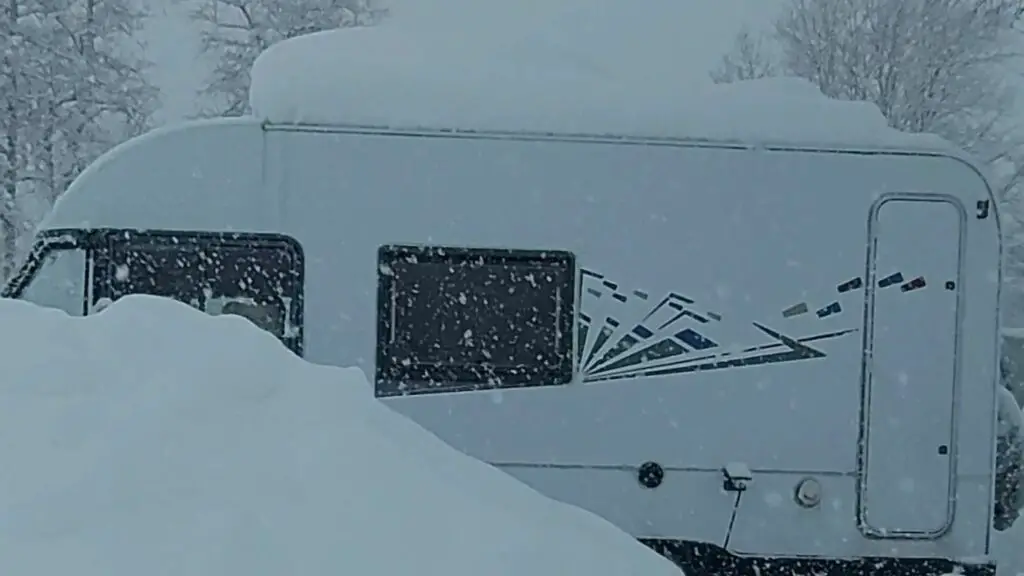
Some RV owners enjoy camping for three seasons out of the year but will store their RVs as winter approaches because they don’t enjoy winter camping. However, if you don’t mind chilly weather, you can live in an RV even during winter as long as you adequately prepare yourself and your RV.
When staying in an RV, you push the limit to what is too cold with a winterized (grade 3) RV at -22°F (-30C). With a winterproofed (grade 2) RV, it is getting too cold at 5°F to -4°F (-15 to -20C). With a grade one or seasonal RV, just below freezing will be too cold unless you make insulation improvements.
Suppose you are not staying in the RV and not using the heater. In that case, it will be too cold for all RVs at freezing temperatures if they are not winterized as the water pipes, tanks, water heater, pumps, and everything that contains water will freeze and could burst but when winterized properly and not in use nothing is too cold.
The Dangers of RV Camping in Extremely Low Temperatures
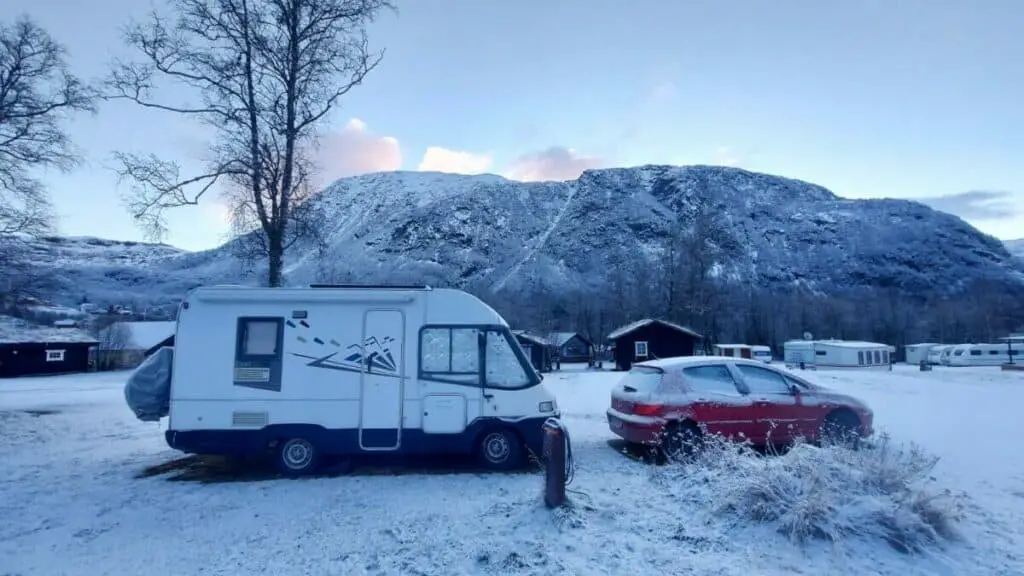
RV camping during winter can be a great experience, especially if you love winter recreational activities. However, this can be dangerous to your RV in extremely low temperatures. The dangers’ extent depends on your RV type, as some RVs are better isolated for colder climates which you can read more about here.
If your RV is made for colder climates, i.e., is a winterized (grade 3) RV, it might be okay even when temperatures outside dip to -22°F (-30°C). However, if you have a poorly insulated RV, it starts feeling the effects of the cold when temperatures reach the freezing point, 0°C (32°F).
A grade one RV that is not properly insulated for winter use will probably have the grey water tank completely exposed to the elements underneath the RV; hence this, along with your sewage pipes, will freeze, and your sinks will start flooding when that happens!
Whereas a grade 3 RV made for winter use will have the grey water tank in an isolated area that is heated by your original heating system, and you won’t have to worry about it, along with the water pipes, sewage pipes, and the whole water system, that is why you can endure much lower temperatures in those.
1. The RV Water Pipes Could Freeze
One of the dangers of RV camping in very low temperatures is that the water pipes can freeze. Winter temperatures are unpredictable. You can’t tell how long a freeze will last, and therein lies the danger. If the water pipes freeze, they could burst.
The reason is that when water freezes inside the pipes, it expands and thus puts pressure on the pipes. As a result, the pipes can burst open, split, or crack. Here’s what happens when water pipes freeze or burst:
- When the water pipes freeze, you have no water to drink, cook or use in the RV, which will run your trip short.
- If water pipes burst, split, or crack, it can be a great disaster as it could ruin your entire plumbing system. This could be a very costly problem as you might get water damage to repair as well.
And yes, RV water pipes can freeze overnight while camping and running the heater. For example, in my poorly insulated motorhome, the water pipe to the kitchen and shower froze at -13 C (8,6 F). However, the bathroom sink never froze, even at -20 C (4 F); this water pipe was better insulated.
You can read more about how long it takes for the pipes to freeze and how to thaw them in my other article.
2. The RV Water System Components Could Freeze
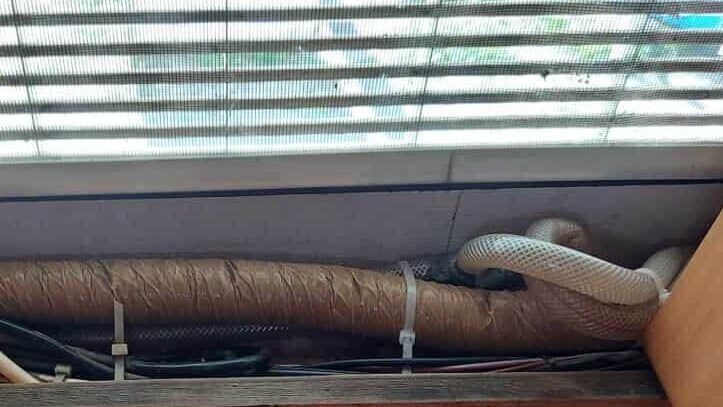
The RV water system components take longer to freeze than water pipes because they are not usually exposed. However, they could freeze if the temperatures remain below freezing point day and night, and they are situated in a poorly insulated part of your RV where the heater doesn’t direct a lot of heat.
Here is one of my most famous articles where I talk about how your RV water pump can freeze and what you can do to avoid it, as well as how to fix it!
2.1 RV Holding Tanks
RV holding tanks store wastewater and freshwater in your RV. Most RVs have at least three holding tanks that include the following:
- Fresh water tank: It stores the fresh water that comes from the freshwater pipes to your faucets.
- Gray water tank: This tank stores dirty water from the RV’s kitchen sink and shower. The gray water tank could be uninsulated and pose a problem at cold temperatures.
- Black water tank: This tank stores the wastewater from your RV’s toilet; some have smaller cassettes instead that you take out from its storage and dump manually.
All of these tanks could freeze, especially if you are not using the RV and its heater, so if you intend on not using the RV, you must drain the whole water system properly before it gets below freezing.
Suppose you are staying in your RV and camping in cold temperatures. In that case, it will all depend on how well-insulated your RV is if or when it will freeze; for example, the freshwater tank is usually situated inside the RV near the heating system, under a couch, or something similar and will usually be the last thing that freezes.
Then the black water tank is also usually fairly insulated and with the heating system spreading warm air in its vicinity.
Still, the grey water tank, as mentioned before, is usually where people encounter problems, and if you have an uninsulated grey water tank, don’t worry; it’s the same for me. Check out this article explaining how I stayed a whole Norwegian winter with temperatures down to -4°F (-20C).
2.2 The RV’s Water Pump
Most RVs have a built-in water pump that distributes water from the freshwater tank to the toilet, shower, and kitchen. The water pump is usually a few feet from the fresh water tank, which might be under the bed or inside a kitchen cupboard.
Freezing temperatures can have a severe effect on your RV’s water pump.
The water pump has components such as motors, gaskets, and seals that frozen temperatures can damage. If the water pipes are frozen, and the water pump’s motor keeps running, the grind and bearing become stripped. This can damage the pump, which in turn, stops it from running.
If your RV’s water system components freeze, here’s what could happen:
- Freshwater tank: If the freshwater tank freezes, you’ll have no water to use in the RV, and it will take time to thaw it out.
- Gray water tank: If it freezes and bursts, you’ll need to thaw it, and if it is close to full, it will probably burst, and you will need to replace it.
- Black water tank: If the black water tank freezes and bursts, the waste will flow out, which can be disastrous. In addition, you have to replace the tank and clean up all the poop you now have everywhere.
- Water pump: If your RV’s water pump becomes frozen and gets damaged, it could cause your pump to fail. You’ll then have no water in your RV.
- Water Pipes: If the water pipes freeze and burst or crack, you might get a smaller leak that you won’t notice for a while, causing serious water damage to your RV that can add up to costly repairs.
3. Snow on the Roof of the RV Can Be Dangerous to the RV
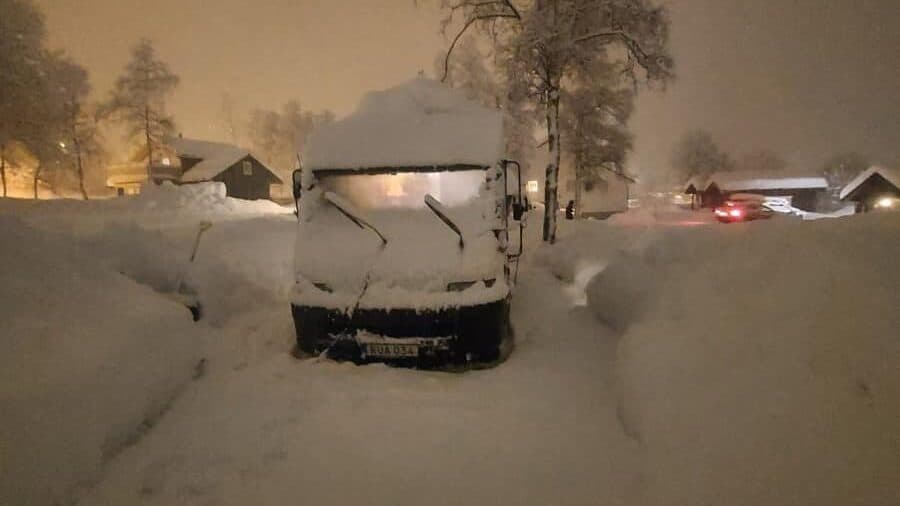
One of the reasons some people love RV camping in winter is the sight of falling snow. However, ice can accumulate quickly, especially on your RV’s roof, and although it looks light, it’s deceptively heavy. If snow stays on the roof and other parts of your RV, it could eventually do the following:
- Cover the RV’s roof vents leading to poor ventilation.
- Cause leaks to the RV’s roof.
- Cause structural damage to the entire RV.
For those reasons, it is important to remove the snow regularly from your RV roof when winter camping, which you can read more about how to do safely here.
4. Snow on the Roof of the RV Can Be Dangerous to You
Snow can also pose some danger to you because if you don’t want the heavy snow to sit on your RV’s roof for an extended period, you’re forced to remove it. However, the RV’s roof is extremely slippery when covered with snow, and if you aren’t careful, you could fall or trip as you try to remove the snow and ice.
Minimizing Dangers of RVing in Extremely Low Temperatures
You can live in your RV during the cold season. After all, some people ski and live in tents on their way to the north/south poles. However, if the temperatures remain below freezing point, 0°C (32°F), you could start having problems with some of your RVs functions.
If you want to RV camp in very low temperatures, prepare your RV and yourself for whatever Mother Nature throws your way and consider what parts of your RV might need extra insulation or better heating; for example, I have put in extra insulation in my RVs floor and use DIY window insulation during the winter.
1. Wrap Heat Tape Around Water Pipes
If you plan to RV camp in winter, wrap heat tape around the water pipes, which transfers heat energy into the pipes and prevents them from freezing, along with insulation on top.
For instance, the MAXKOSKO Water Pipe Heat Tape (available on Amazon.com). It can supposedly keep the water flowing even when temperatures dip to -40°F (-40°C); just be aware that it requires 120 volts, so you will probably need to be hooked up to electricity to use it.
2. Install a Heater Pad on the Holding Tanks
One way to keep your RV’s fresh water tank from freezing is to install a heater pad that insulates the freshwater tank and prevents the water from freezing. For instance, the Facon RV Tank Heater Pad (available on Amazon.com) is excellent as it has a built-in thermostat that turns on and off based on the outside temperatures.
3. Add Non-Toxic Antifreeze to the Black and Gray Tanks
To prevent your gray and black tanks from freezing, you can add some non-toxic antifreeze. The CPDI Champion Marine and RV Antifreeze (available on Amazon.com) would be a great product as it guarantees burst-proof protection even when temperatures are as low as -50°F (-10°C).
4. Use the Original RV Heating System Instead of Only a Space Heater
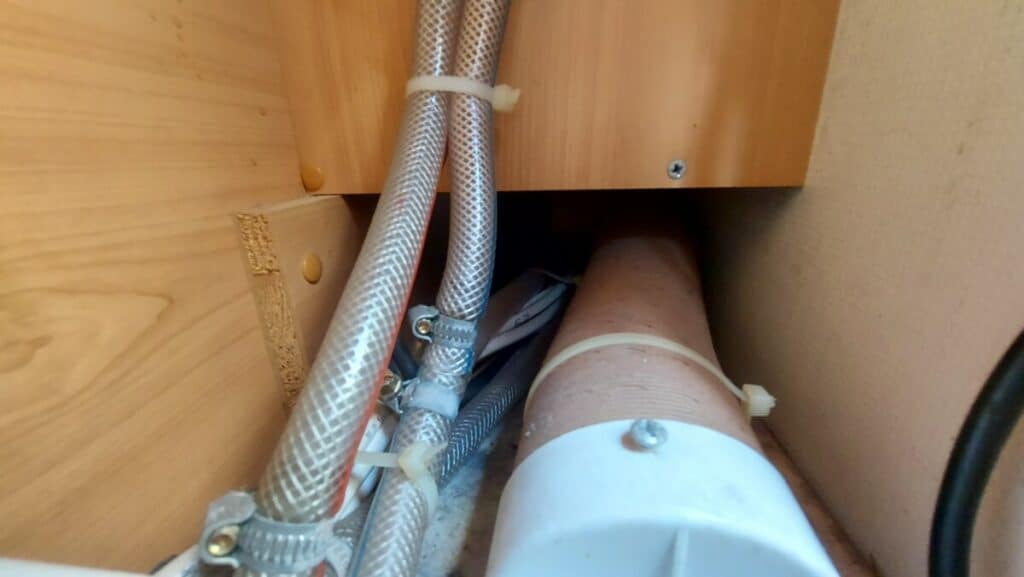

One great way of preventing your water pump, pipes, and your whole RV water system from freezing is by using the furnace/ original heating system in your RV, as it is built in a way where it should spread out the heat evenly throughout the whole RV and especially to the critical places that need it the most.
5. Take Precautions When Removing Snow From the RV’s Roof
An RV roof can be extremely slippery with ice and snow, and it’s best to take precautionary measures when removing snow from the roof, such as:
- Use a ladder: Using a ladder when removing snow from the RV’s roof prevents you from tripping or falling on the roof, but only if you have a steady and sturdy ladder; otherwise, that will be the dangerous part.
- Use a push broom: You might want to use a push broom to remove snow from the RV’s roof or at least not a metal shovel, as it is very easy to scratch and damage the roof that way.
6. Keep Yourself Warm in the RV
When RV camping in freezing temperatures, it’s important to keep warm to have a good experience.
- Wear warm clothes.
- Layer up.
- Use an electric blanket like the WAPANEUS Heated Blanket (available on Amazon.com), which is excellent for keeping you warm at night.
7. Keep the RV Warm
You can protect yourself further from the cold by keeping the RV warm, such as:
- Keep the RV’s furnace running at high temperatures.
- Use small space heaters in addition to the furnace, never instead of.
- Insulate the RV’s windows and floors.
- Use thermal curtains.
8. Prevent Carbon Monoxide Poisoning
You must keep your RV’s propane furnace running for an extended period during frigid temperatures, which could lead to carbon monoxide poisoning. You can prevent carbon monoxide poisoning by doing the following:
- Service the RV’s fuel-burning appliances before you go camping in winter to ensure that they work efficiently.
- Get a carbon monoxide detector to alert you when the RV’s carbon monoxide levels are high.
- Ventilate the RV when the furnace is on by cracking open a down-low window and one up high. However, this is usually never needed as RVs are often too well-ventilated, which makes them cold instead. It is essential to remember this if you cover all the ventilation holes in order to decrease drafts, they are not always a bad thing.
9. Use a Dehumidifier To Prevent Mold Buildup
Using a dehumidifier is one of the best ways of preventing mold buildup in your RV. You can choose either an electric or a desiccant dehumidifier. Here is what a dehumidifier does for your RV:
- It lowers the RV’s humidity levels and prevents mold buildup.
- It keeps the air fresh in the RV.
Conclusion
How cold is too cold for an RV depends on the ability of your RV to withstand cold. For many RVs, 0°C (32°F) is too cold, as some things start freezing and may even stop working. However, some RVs are for colder climates and can thus withstand temperatures as low as or colder than -30°C (-22°F).
